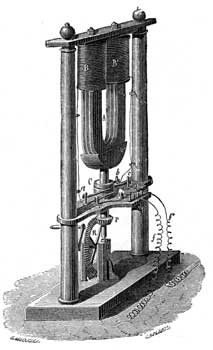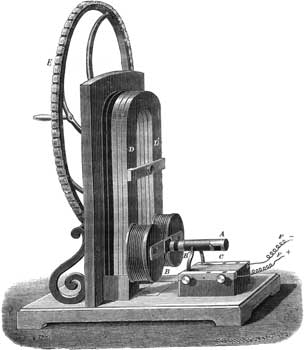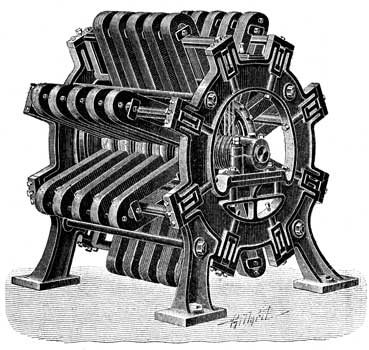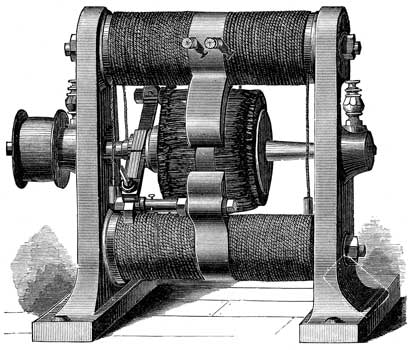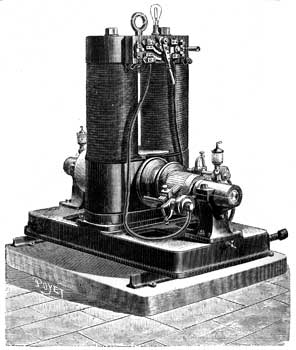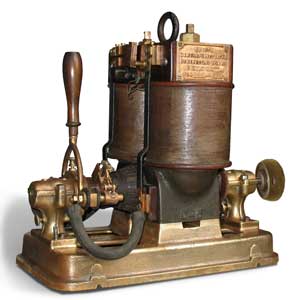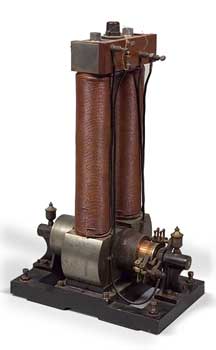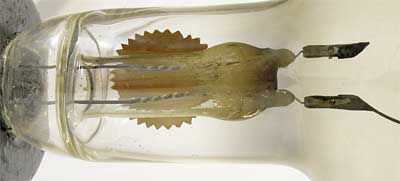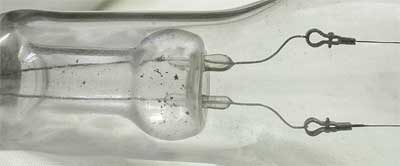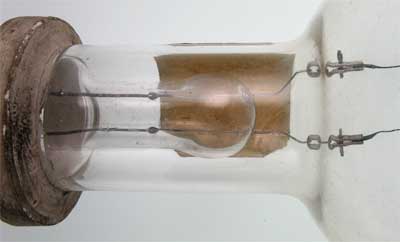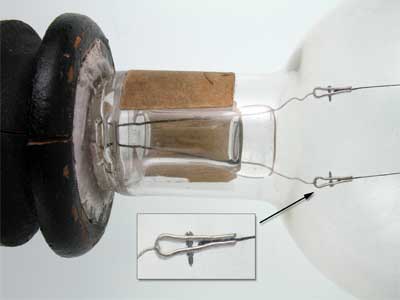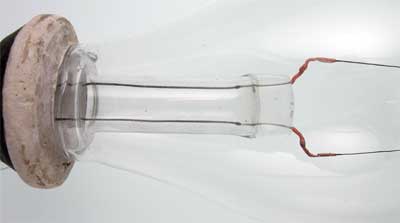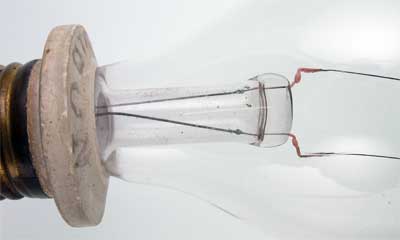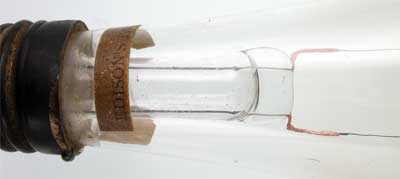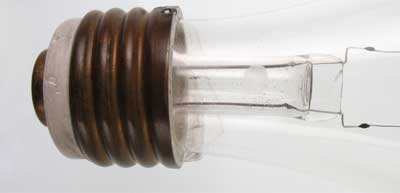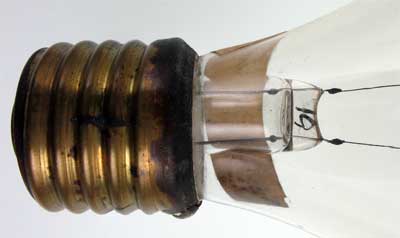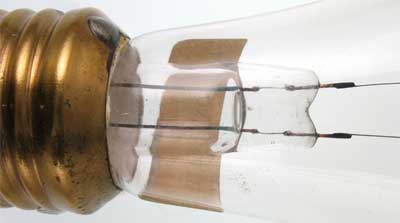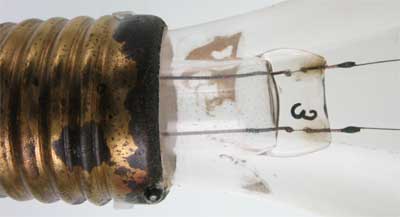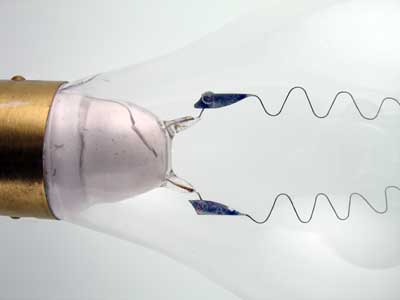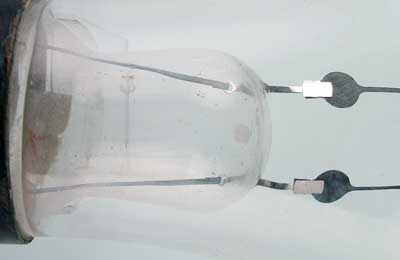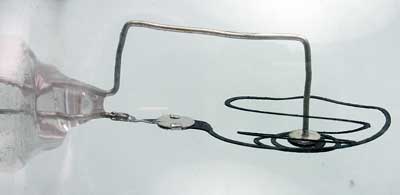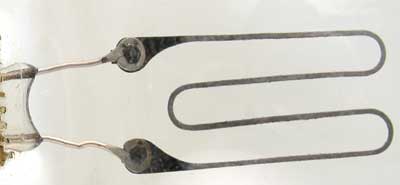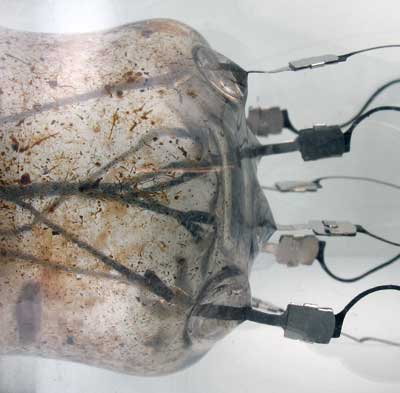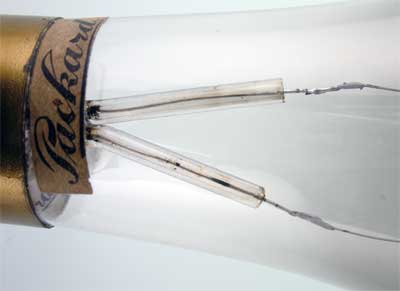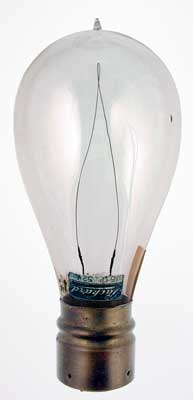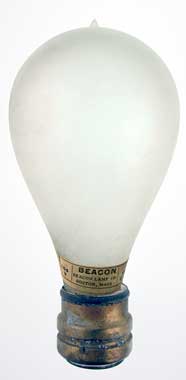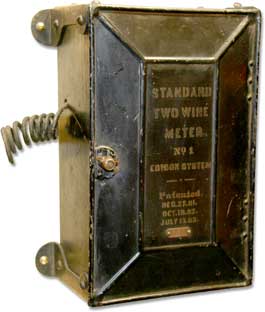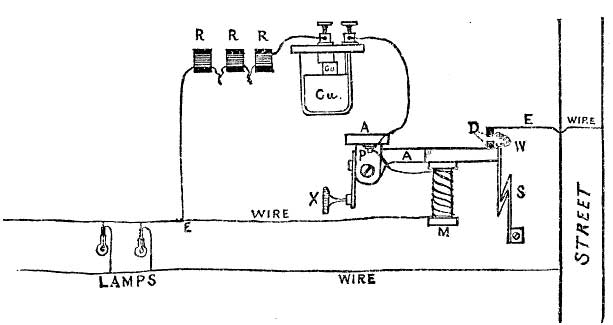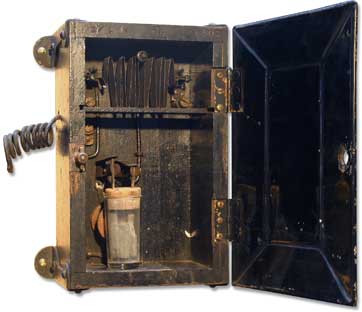| Contact |
| Back | Next | Home |
Electric Lighting
This page is under construction.
Artificial Light Before Electricity
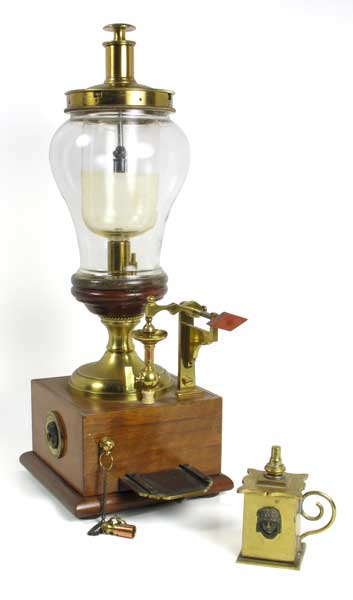
Platinum Sponge Lighter
ca. 1830
Oil lamps were the predominant source of artificial light in the the early 19th century. Lighting them was difficult, however, until the widespread availability of matches around the middle of the century. In the meantime, a number of creative approaches were tried, with varying degrees of success. This device, called a platinum sponge lighter, utilized a small piece of platinum similar to steel wool suspended in a glass enclosure. When hydrogen gas was allowed into the container, the platinum would spontaneously burst into flame, igniting the hydrogen, which appeared as a small jet of flame. The small alcohol lamp in the foreground was then ignited from this flame. Once the alcohol lamp was burning, the hydrogen fire was extinguished. The alcohol lamp could then be carried throughout the building, to light the oil lamps.
Unfortunately the apparatus was tricky to operate, and the wrong mix of hydrogen and air would result in an explosion. Perhaps that is why so few hydrogen lamps survive today.
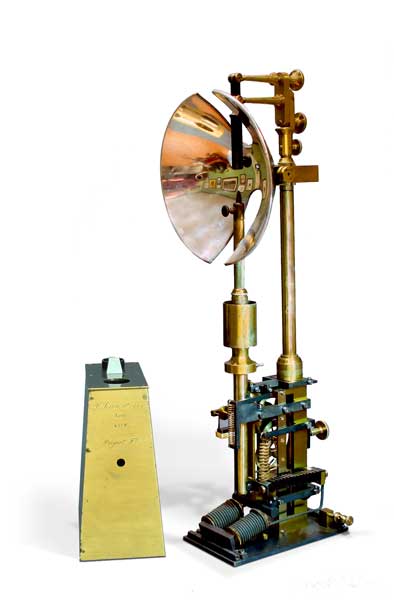
Serrin Electric Arc
Lamp
Breguet
ca.
1857
What you see here is the only known example of the
first self-starting and self-regulating arc lamp invented by Victor Serrin
of Paris, and built in 1857 by the great French instrument maker,
Breguet. This beautiful lamp represents an important step
in the evolution of the electric light. During the 1850s many people had devised electromagnetic
regulators to maintain the arc as the carbon electrodes burnt down.
However, in order to start the arc, the carbon rods had to be touched
together briefly and then separated. Existing mechanisms required that the lamp be
started manually. This was a big problem especially if the lamp
was in a hard to reach area or if it went out once it had been
started. Serrin's design proved popular and was soon
adopted as the main choice for French light houses where it served for many years. All of this took place 22 years before Thomas Edison perfected his incandescent lamp!
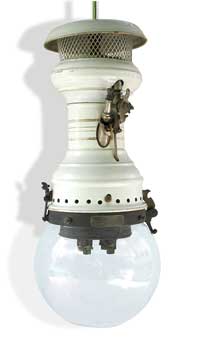
Welsbach "Arc" Lamp
Invention of the Dynamo
|
|
|
|
|
|
|
|
|
|
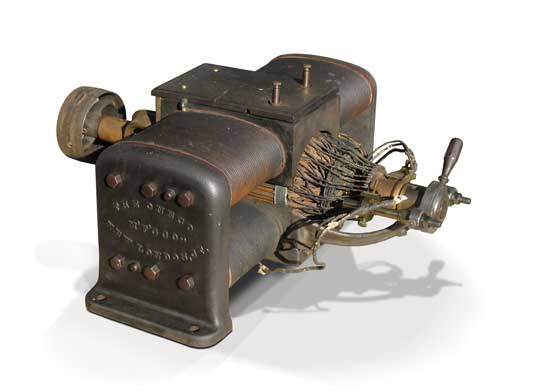
Oneco Bipolar Dynamo
Circa 1890's
|
|
|
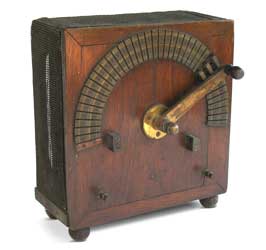 Very
early Dynamo Regulator. Signed US Electric
Lighting Co. NY (stamped onto the adjusting arm lever.) Regulators
such as this were used in early electric lighting circuits to adjust
the dynamo output. The regulator consists of a rheostat (adjustable
resistance) placed inside a wooden box. The device is connected to the
dynamo field circuit, and by turning the handle the dynamo may be
adjusted to run any number of lights from one to the maximum load. Very
early Dynamo Regulator. Signed US Electric
Lighting Co. NY (stamped onto the adjusting arm lever.) Regulators
such as this were used in early electric lighting circuits to adjust
the dynamo output. The regulator consists of a rheostat (adjustable
resistance) placed inside a wooden box. The device is connected to the
dynamo field circuit, and by turning the handle the dynamo may be
adjusted to run any number of lights from one to the maximum load. The United States Electric Lighting company (USEL) was an early competitor to Edison, formed by Weston, Maxim, and Farmer, the latter two having claimed priority to the incandescent lamp. USEL and Edison were the first companies in the United Stated to develop a metering and controlling system for dynamos. Mahogany frame is covered with coarse metal screen on sides and back, and is supported by four round wooden feet. Measures 10-1/2 x 11-3/4 x 6-1/2. The number 1427 is stamped into the front panel. Beautiful example of an early and very rare dynamo regulator. American, circa 1881
|
|
Early attempts at Incandescent Lighting
Edison's Invention: A Practical Incandescent Lamp
|
|
|
Rarest Edison Lamp. This one was shown in
Edison's 1879 New-Year's eve demonstration at Menlo Park. |
The Arc Lamp
Early Fixtures and Hardware
Early Examples of Incandescent Lamps
1879 - 1888
 |
 |
 |
|
Edison spear point lamp with |
Edison lamp using |
Early Edison Lamp with later |
 |
 |
 |
|
Edison Lamp with |
Edison Lamp with |
Edison Lamp with |
|
|
|
|
Edison lamp - Very rare |
Edison hairpin carbon lamp |
Evolution of the Stem Press
|
|
|
|
Early round seal stem (called the
"pantaloon" because of it's shape) with long platinum press leads
twisted & soldered to outer leads. Screw clamps connect inner leads to
filament |
Early round seal
"Petticoat" press showing glass tubes on inner leads. Screw clamps
connect inner leads to filament 1880 |
|
|
|
|
Early round stem with no glass
tubes, "Smooth" press, screw clamps connect inner leads to filament. |
Flat seal stem with long platinum
inner leads connecting to screw clamps. |
|
|
|
| Flat seal stem, copper
plated clamps connect platinum press leads to filament. 1881 |
Same as previous
example, but with platinum press leads are made shorter to reduce cost. 1883 |
|
|
|
| Similar to previous,
but without plaster ring 1884 |
Flat seal stem ,
conductive paste used to attach "goal-post" style inside leads to
filament. Note short base. Edison produced very few lamps with
this configuration. 1885-87 |
|
|
|
| Flat seal stem,
platinum press leads reduced further 1888 |
Flat seal stem,
platinum reduced significantly by embedding the lead welds inside
the glass seal. 1889 |
|
|
|
|
Flat seal stem, platinum reduced to
a minimum. |
Later type with copper tips
omitted and platinum leads run through the seal, but with remaining
welds still embedded in the glass |
Other Unusual and Early Stems, Clamps, and Presses
|
|
|
|
Weston w/ Tamadine filament
|
Perkins-Mather carbonized paper hairpin filament
|
|
Perkins-Mather spiral filament |
Maxim |
|
Perkins-Mather multi-filament
|
|
Edison Lamps with Non-Edison bases
(All date from the 1890's)
 |
 |
|
New Type Edison with Brush-Swan base |
New Type Edison with
Hawkeye base |
 |
 |
| New-Type Edison
Cranberry with Westinghouse base |
New-Type Edison with
Perkins-Mather base |
 |
 |
| New-Type Edison with
Edison base |
New-Type Edison with
Shaeffer base |
 |
 |
| New-Type Edison Frosted
with Thomson-Houston base |
New-Type Edison with
U.S. base |
 |
 |
| New-Type Edison with
combo Westinghouse-Edison base |
Edison Jr. frosted
mushroom with Thomson-Houston base |
 |
 |
| New-Type Gilmore with
Edison base |
Edison with Edison base. Etching on glass reads "Edison Lab" |
New-Type Edison Color Lamps
(1890's)
 |
 |
 |
 |
Other Early Lamps
 Perkins-Mather hairpin carbonized paper filament & Platinum clamps 1880's |
 Perkins-Mather multi-filament 1880's |
 Perkins-Mather spiral filament 1880's |
 Perkins-Mather hairpin filament 1890 |
| The three Perkins-Mather lamps shown above left are very rare, these are the only known to exist. If you are aware of others, please contact me. | |||
|
|
||
 New-Type Edison Railway Series |
 Edison hairpin filament 1888 |
 Packard 32cp Lamp, Thomson-Houston base |
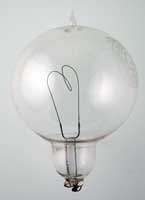 Swan, no base |
 Maxim, no base 1880 |
 Maxim, very uncommon with unusual base 1880 |
 Shelby tipless cranberry mushroom 1900 One of the first tipless lamps |
 Unknown milk glass lamp w/ Edison base |
 Brush-Swan milk glass with wood base 1885 |
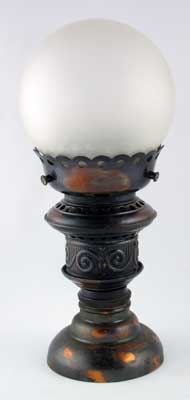 |
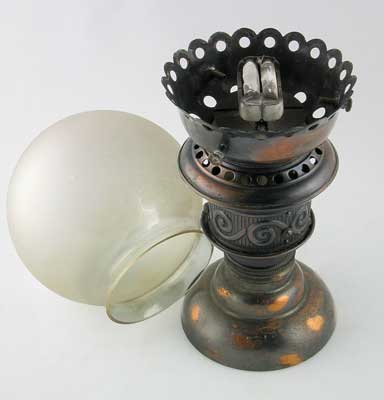 |
|
| Nernst -
General Electric lamp with socket base |
||
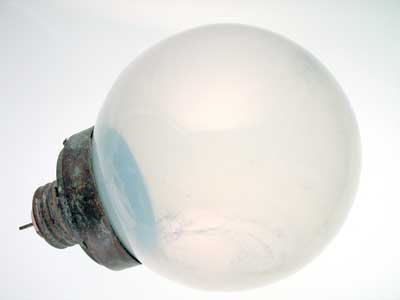 Nernst Lamp - Westinghouse |
||
|
|
|
|
|
|
|
|
|
|
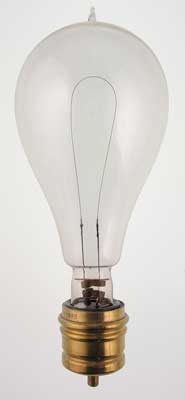 Beacon stopper w/Westinghouse base 1892 |
|
|
|
 Austrian deco white lamp 1900 |
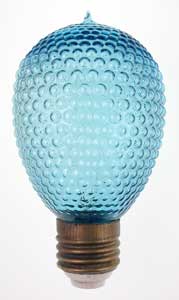 Austrian deco aqua lamp 1900 |
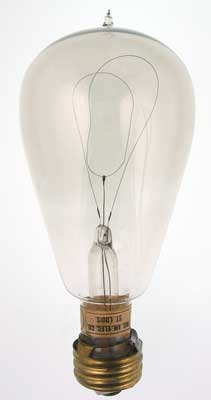 Miller patent lamp 1900 |
 Beacon w/ Thomson-Houston base early 1890's |
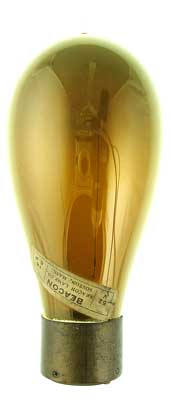 Beacon w/ Thomson-Houston base, dark amber early 1890's |
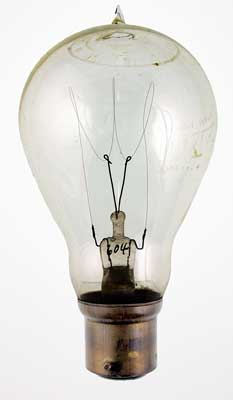 Maxim w/Swan base |
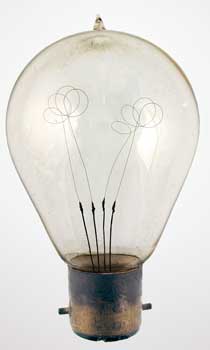 Swan w/ Swan base |
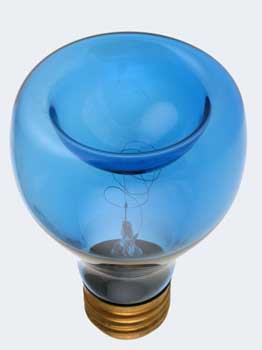 Vic's Vapo-Lite, cobalt blue |
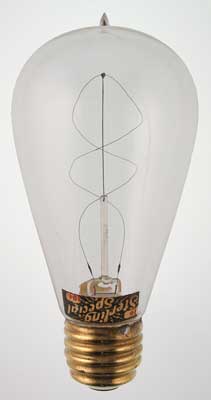 Sterling spiral 1900 |
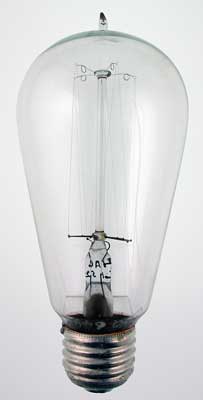 Edison standard candlepower tungsten filament lamp 1912 |
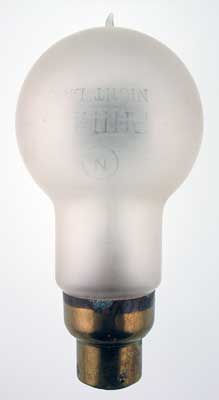 Philips Neon 'Night Light' c. 1923 |
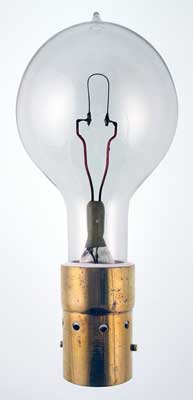 Heissler w/ unusual base 1890 |
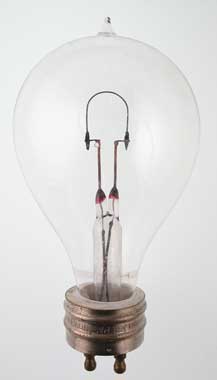 Hesissler w/nickel base 1895 |
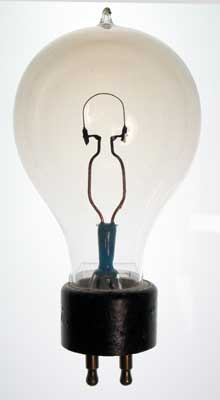 Hesissler w/hard rubber base 1900 |
 Brush -Swan 1885 |
 Brush-Swan |
 Hawkeye, w/ Hawkeye base (probably made by Packard) |
 Swan w/ hookeye base 1880's (Socket for screwing into gas fixtures) |
 Swan or Thomson w/ hookeye base 1880's (Socket for screwing into gas fixtures) |
 Sunbeam, no base late 1880's Rare, early example |
 Shelby Mushroom w/ Westinghouse base 1900 |
 Shaefer w/ Shaefer base mid-early 1890's |
 Siemens & Halske w/ Siemens & Halske base |
 Westinghouse cranberry glass w/ Westinghouse base early 1890's |
 Early Westinghouse w/ Byllesby-Lange base 1889 |
 Peerless w/ Brush-Swan base late 1890's |
 Sterling spiral w/ Thomson-Houston white porcelain base 1900 |
 Colombia w/ Edison base mid-1890's |
|
More Lamps
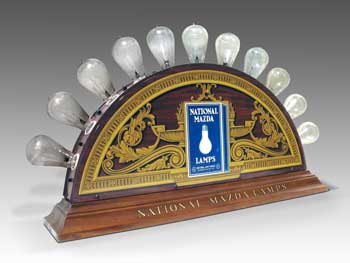
 |
|
|
Rare Early Edison X-Ray tube (from Edison Historic Site, West Orange, New Jersey) |
|
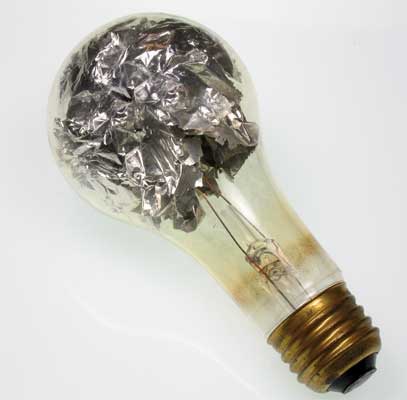 |
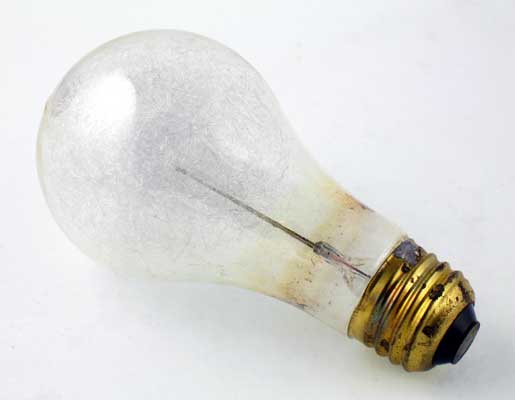 |
| Early Photographic flash bulb using
aluminum foil and Oxygen gas 1931 |
Later, but early photographic flash
bulb using spun magnesium |
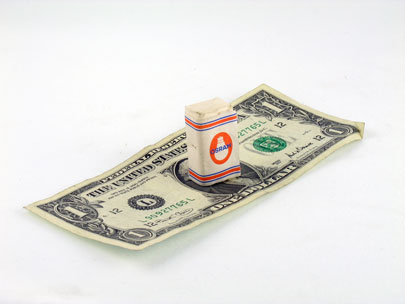 |
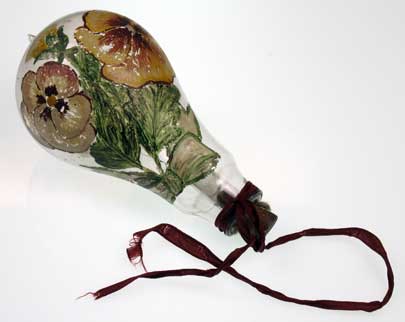 |
| Osram Miniature lamp |
Hand-painted decorative lamp made into
a perfume bottle |
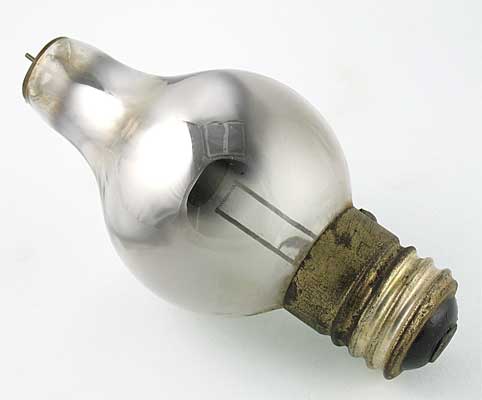 |
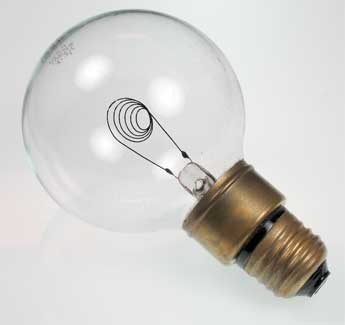 |
| Ediswan Tungar Rectifier |
GE 120v 250W "Dri-Ray" Lamp |
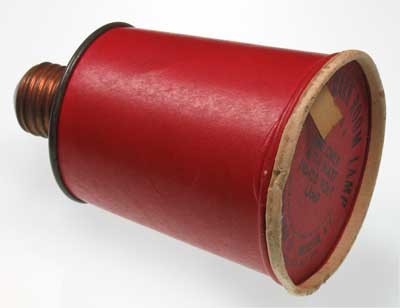 |
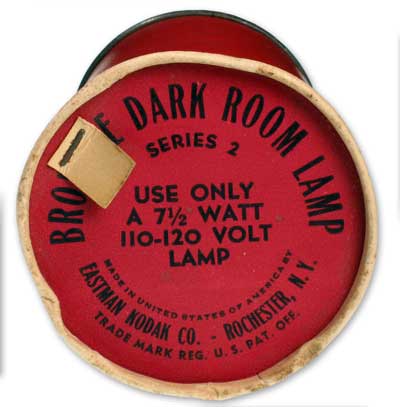 |
| Kodak Brownie Darkroom Lamp | |
 |
|
| Champion Tungsten Lamp with sleeve | |
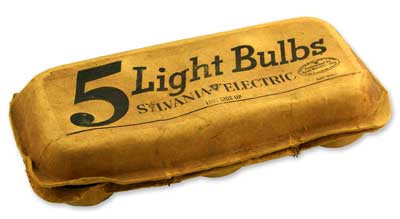  Sylvania "Egg Crate" colored lamps |
|
Early Power Meters
The Edison Chemical Meter
Edison set up his first power station in New York City at Pearl
Street. The station began operation on September 4, 1882. In
order to keep track of the electricity used by his customers, Edison
designed the first electric wattmeter, called the "Chemical meter" (see
below.)
|
|
It was a crude device based on the principle of electroplating, developed by Michael Faraday. Faraday had found that the transfer of metal from one plate to another in an electrolytic bath was exactly proportional to the current. Edison's first meter held a small glass jar in which two copper plates were suspended in a solution of copper sulphate. The cover of the cell was arranged so that one of the plates was easily removable by means of an insulated clamp with a thumb screw; the other plate, which was thick and cylindrical in form, was intended to remain in the cell to allow the copper to be transferred from it to the other plate via electrolysis. An Edison employee would visit the meter periodically, remove the electrode and weigh it, and the customer would be billed accordingly.
While the concept worked well in theory, in practice it was inconvenient and not especially accurate. Worse, there was no way for a customer to independently confirm their consumption of electricity so their confidence in the device was not high. As a result the meters were replaced in short order, and very few can be found today.
|
|
|
|
|
|
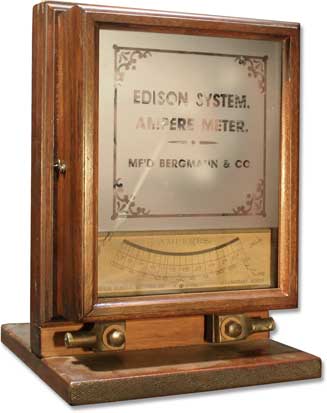 Edison Ammeter Edison General Electric
|
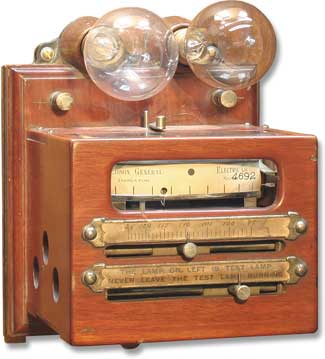 Edison General Electric |
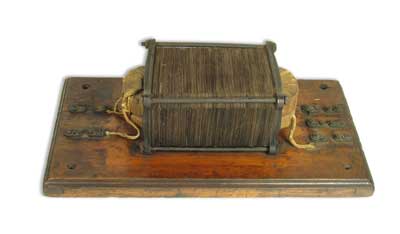 Westinghouse Converter The first AC line transformer ca. 1888 |
|
| Contact |
| Back | Next | Home |
